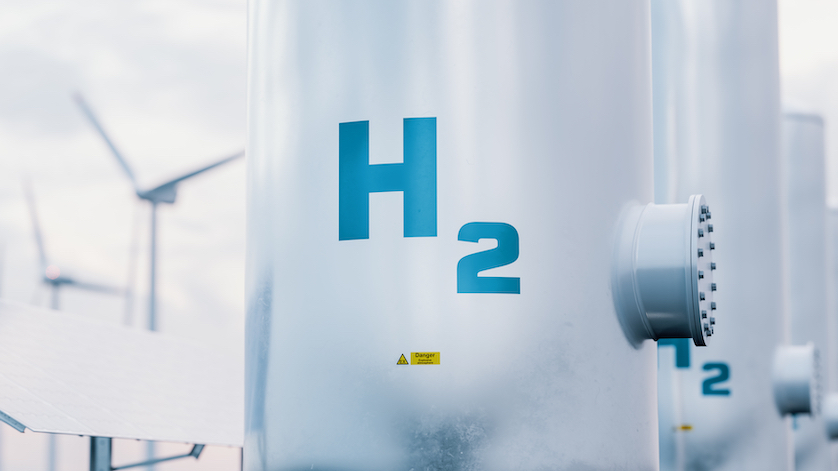
Hydrogen is key to decarbonization – in the chemical industry as well as for developed nations. However, while it is relatively easy and cheap to produce, pure H2 is notoriously difficult to transport and store. Most methods require high operational and/or energy costs.
H has the least mass of all known elements, and H2 is the lightest of all molecules. Thus, hydrogen has an extremely low density at atmospheric pressure. In order to store and transport it efficiently, it must first be condensed. Conventional methods include:
- High-pressure compression – for H2 in a gaseous state, pressures of 5,000 to 10,000 psi (350 to 700 bar) or more
- Cryogenic liquefaction – for H2 in a liquid state, cooling it below its boiling point of −423°F (−253°C, 20.28 K)
- Solid-state storage – adsorption for hydrogen storage on the surface of solids; absorption for hydrogen storage within the lattice framework of solids
All three approaches involve high operational and/or energy costs (Rao & Yoon, 2020):
- Tanks that can withstand such high pressure require the use of expensive composite materials.
- Liquefying hydrogen requires a multi-storage cooling process and expending the equivalent of ~40% of its energy content.
- The downsides of solid-stage storage:
- low gravimetric capacity of <5.5 wt% (the DOE has 6 wt% as the target)
- limited reversibility under optimal pressures and temperatures
- instability of storage materials
- requirement of low temperatures (−321°F / −196°C)
These costs, especially in terms of energy, have a negative impact on the net-zero potential of hydrogen use, especially if the required energy comes from nonrenewable sources. The energy costs of transporting hydrogen long distances and storing it for long periods add to this conundrum.
For these reasons, researchers are working on novel, less energy- intensive ways to store hydrogen. One process that shows promise is the use of liquid organic hydrogen carriers (LOHCs), which also opens up new possibilities for heat capture and catalyst regeneration.
LOHC Systems: Many positives (and a few negatives)
As their name implies, liquid organic hydrogen carriers are carbon-hydrogen or carbon-carbon compounds that remain a liquid at ambient temperatures and pressures. To carry hydrogen, hydrogen-lean LOHCs react with hydrogen in an exothermic catalytic reaction at elevated pressure (435–725 psi / 30–50 bar) and high temperatures (302–392°F / 150–200°C). Once saturated, LOHC stores hydrogen relatively safely in ambient conditions. When the hydrogen is needed, the hydrogen-rich LOHC releases hydrogen in an endothermic catalytic reaction at higher temperatures (482–608°F / 250–320°C). This hydrogenate/dehydrogenate process is easier and more economical than compressing or liquefying hydrogen, and has a greater carrying capacity than solid-stage storage.
Researchers are currently experimenting with different hydrogen-rich and hydrogen-lean compounds to see which ones offer the most positives and fewest negatives. These pairs include methylcyclohexane (MCH)/toluene, and perhydro-dibenzyltoluene/dibenzyltoluene, decalin/naphthalene.
LOHC systems are receiving so much attention because they, in principle, allow the storage and transport of massive quantities of hydrogen for an almost unlimited time – and all without the risk of hydrogen leakage. In fact, the only limitations on quantity and duration depend on the tank size and technical characteristics of the LOHC compound. Moreover, unlike other Power-to-X concepts*, LOHC systems allow energy storage without releasing CO2 or N2 into the atmosphere. Thus, this type of hydrogen storage is a positive step toward realizing the potential of H2 as a climate-friendly fuel.
However, LOHC systems are not without some downsides. For example, while dibenzyltoluene is slow to combust, it should not be touched or ingested, and is a hazard if it enters the water supply. Working with LOHCs require taking the highest safety precautions, necessary for protecting the environment, human health, and companies. And this requires continuous control by means of accurate, reliable measurement technology.
This article follow “The Danger of Hydrogen Leaks and How to Minimize the Risk.” Next in the series: “Measurement Technologies for a Hydrogen Economy.”
* Power-to-X refers to pathways that convert, store, and reconvert the surplus electricity generated using solar, wind, and other renewable sources (power) into a wide range of products (X), such as transportation fuels, chemicals, and heat. Used mostly in northern Europe, this catch-all term is a shorthand for turning green energy to green fuel.

